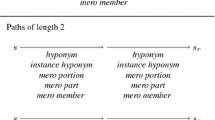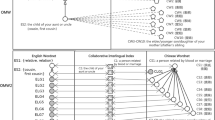Abstract
This paper discusses the design of the EuroWordNet database, in which semantic databases like WordNet1.5 for several languages are combined via a so-called inter-lingual-index. In this database, language-independent data is shared whilst language-specific properties are maintained. A special interface has been developed to compare the semantic configurations across languages and to track down differences.
Similar content being viewed by others
References
Ageno A., F. Ribas, G. Rigau, H. Rodriquez and F. Verdejo. TGE: Tlinks Generation Environment. Acquilex II (BRA 7315) Working Paper 7. Polytecnica de Catalunya, Barcelona, 1993.
Alonge, A. Definition of the Links and Subsets for Verbs. EuroWordNet Project LE4003, Deliverable D006. University of Amsterdam, Amsterdam, Http: //www.let.uva.nl/∼ewn, 1996.
Apresjan, J. “Regular Polysemy”. Linguistics, 142, 1973.
Bloksma, L., P. Díez-Orzas and P. Vossen. The User-Requirements and Functional Specification of the EuroWordNet-project. EuroWordNet deliverable D001, LE2-4003. University of Amsterdam, Amsterdam, Http: //www.let.uva.nl/∼ewn, 1996.
Buitelaar, P. Corelex: Systematic Polysemy and Underspecification. PhD. Thesis, Department of Computer Science, Brandeis University, 1998.
Climent, S., H. Rodríguez and J. Gonzalo. Definition of the Links and Subsets for Nouns of the EuroWordNet project. EuroWordNet Project LE4003, Deliverable D005. University of Amsterdam, Amsterdam, Http: //www.let.uva.nl/∼ewn, 1996.
Copeland, C., J. Durand, S. Krauwer and B. Maegaard (eds.). The Eurotra Formal Specifications. Luxembourg: Office for Official Publications of the European Community, 1991.
Copestake A. and T. Briscoe. “Lexical Operations in a Unification-based Framework”. In Lexical Semantics and Knowledge Representation. Ed. J. Pustejovsky and S. Bergler, Association for Computational Linguistics, 1991.
Copestake A., T. Briscoe, P. Vossen, A. Ageno, I. Castellon, F. Ribas, G. Rigau, H. Rodriguez and A. Sanmiotou. “Acquisition of Lexical Translation Relations from MRDs”. Journal of Machine Translation, 9(3), 1995.
Copestake A. and A. Sanfilippo. Multilingual Lexical Representation. Acquilex II (BRA 7315) Working Paper 2. Cambridge University, 1993.
Copestake, A. “Representing Lexical Polysemy”. Proceedings of AAAI. Stanford: Stanford Spring Symposium, 1995.
Cuypers, I. And G. Adriaens. Periscope: the EWN Viewer. EuroWordNet Project LE4003, Deliverable D008d012. University of Amsterdam, Amsterdam. Http: //www.let.uva.nl/∼ewn, 1997.
Díez-Orzas P. and I. Cuypers. The Novell ConceptNet. Internal Report, Novell Belgium NV, 1995.
Díez Orzas, P., M. Louw and Ph. Forrest. High Level Design of the EuroWordNet Database. EuroWordNet Project LE2-4003, Deliverable D007. 1996.
Louw, M. The Polaris User Manual. Internal Report, Lermout & Hauspie, 1997.
Levin, B. English Verb Classes and Alternations, a Preliminary Investigation. Chicago/London: University of Chicago Press, 1993.
Miller, A., R. Beckwidth, C. Fellbaum, D. Gross, and K. J. Miller. “Introduction to WordNet: An On-line Lexical Database”. International Journal of Lexicography, 3(4) (1990), 235–244.
Nirenburg, S. (ed.). “Knowledge-based MT”. Special issue Machine Translation, 4(1 and 2) (1989).
Nunberg, G. and A. Zaenen. “Systematic Polysemy in Lexicology and Lexicography”. In Proceedings of EURALEX'92. University of Tampere, 1992.
Ostler, N. and S. Atkins. “Predictable Meaning Shift: Some Linguistic Properties of Lexical Implication Rules”. In Lexical Semantics and Knowledge Representation. Ed. J. Pustejovsky and S. Bergler, Association for Computational Linguistics, 1991.
Peters, W., I. Peters and P. Vossen. “Automatic Sense Clustering in EuroWordNet”. Proceedings of the first LREC Conference. Granada, 1988.
Procter, P. (ed.). Longman Dictionary of Contemporary English. Harlow and London: Longman, 1987.
Pustejovsky, J. The Generative Lexicon. Cambridge MA: MIT Press, 1995.
Vossen, P. Grammatical and Conceptual Individuation in the Lexicon. PhD. Thesis, University of Amsterdam, IFOTT, Amsterdam, 1995.
Vossen, P. Right or Wrong: Combining Lexical Resources in the EuroWordNet Project. In Proceedings of Euralex-96M. Eds. M. Gellerstam, J. Jarborg, S. Malmgren, K. Noren, L. Rogstrom and C. R. Papmehl, Goetheborg, 1996, pp. 715–728.
Zwicky, A. and J. Sadock. “Ambiguity Tests and How to Fail Them”. In Syntax and Semantics 4. Ed. J. Kimball, New York: Academic Press, 1975.
Author information
Authors and Affiliations
Rights and permissions
About this article
Cite this article
Peters, W., Vossen, P., Díez-Orzas, P. et al. Cross-linguistic Alignment of Wordnets with an Inter-Lingual-Index. Computers and the Humanities 32, 221–251 (1998). https://doi.org/10.1023/A:1001134011927
Issue Date:
DOI: https://doi.org/10.1023/A:1001134011927




